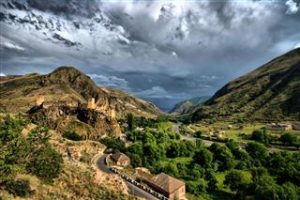Citrus groves, snowy mountains, sandy beaches and gregarious hosts – Guria offers all these to you. Music and singing play a vital role in Gurian culture, where people are known to have conversations in humorous verse. The amazing, yodel-like Krimanchuli (the word means ‘twisted iron’) signing style originates here, when up to seven different voices harmonize in a chaotic yet awe inspiring feat of musical dexterity – you have never heard anything like it. Another Gurian favorite is Naduri, a special song performed while working in the fields. Traditionally, the song would last for longer than an hour and over 200 people sang it together during work.
There are no large towns in Guria, but that is more than made up for by the hundreds of picturesque villages that dot the landscape. The warm, wet climate here during most of the year led to the development of a charming vernacular style, with delicately carved wooden houses perched on brick columns to maximize air flow. To this day, there are whole villages built in this charming way.
Guria is also home to some of the most fascinating and well-preserved traditions in Georgia. Every Easter, the village of Shukhuti erupts into a massive, free-for-all rugby-like game called Lelo, officiated by the local priest. This is the last place this game, once common throughout medieval Georgia, is still played, and the sight of villagers chasing after a huge, 16 kilo leather ball is not to be missed. During the summer, in the mountain village of Bakhmaro, Georgia’s biggest traditional horserace takes place, with dozens of riders going hell-for-leather over the alpine pastures. Indeed, Gurian horsemanship is world-renowned. In the 1880s hundreds of Gurians were recruited by Buffalo Bill to take part in his Wild West Show (they were erroneously marketed to the public as ‘cossacks’). Their tricks wowed the crowds for years, and it is thought that many of the stunts seen in Rodeos today were brought to America by Gurians.

